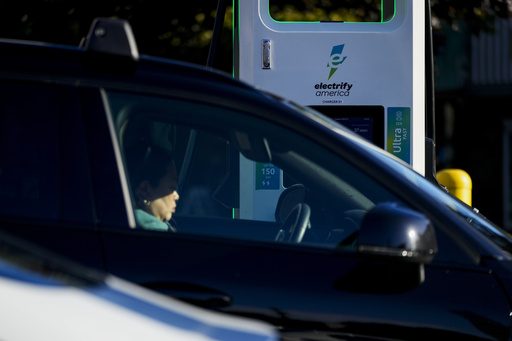
The Biden administration is investing substantial funds into clean energy initiatives and granting approvals for significant offshore wind projects as part of a dash to cement climate accomplishments before President Joe Biden’s term concludes. Biden aims to leave a legacy of climate action, focusing on establishing a path for reducing greenhouse gas emissions that contribute to global warming. Former President Donald Trump has vowed that, if he wins back the presidency, he will eliminate unspent resources from Biden’s climate and healthcare legislation and halt offshore wind developments.
Vice President Kamala Harris, having stepped into the race for the Democratic nomination after Biden’s withdrawal this summer, has asserted her intention to continue a climate strategy akin to Biden’s, aimed at decreasing emissions, advancing renewable energy, and generating clean energy employment opportunities. In recent months, there has been an uptick in announcements regarding significant environmental funding and project approvals, with White House Deputy Chief of Staff Natalie Quillian noting that Biden is “sprinting to the finish” in fulfilling commitments to bolster clean energy and mitigate climate change.
This summer, the Environmental Protection Agency announced the availability of $20 billion from a federal “green bank” for clean energy schemes, which encompass household heat pumps, electric vehicle charging stations, and community cooling facilities. In September, the Bureau of Ocean Energy Management sanctioned the country’s tenth sizable offshore wind farm, the Maryland Offshore Wind Project, marking a significant step toward Biden’s aim of achieving 30 gigawatts of offshore wind capacity by 2030. Moreover, on October 1, the agency granted critical support for an offshore wind farm initiative in New Jersey.
In the last month, the Energy Department disclosed six multi-billion dollar ventures, among them over $3 billion allocated for battery production and a $1.5 billion loan for revitalizing a nuclear facility in Michigan. Additionally, Biden mandated a decade-long timeline for urban centers to replace lead pipes, complemented by $2.6 billion in assistance from the EPA for community compliance.
Apart from the Inflation Reduction Act, Biden is seeking to launch numerous projects under the bipartisan infrastructure legislation passed in 2021 and the 2022 CHIPS and Science Act. The $1 trillion infrastructure initiative earmarks funds for various projects, such as roads, bridges, and ports, while the CHIPS law aims to revitalize the U.S. semiconductor industry with significant government investments.
Experts in the energy sector express that the recent flurry of announcements is anticipated. Trevor Houser, a partner at Rhodium Group, remarked that the imminent possibility of leadership change in the White House likely heightens urgency around initiating these programs. Matt Lockwood, vice president at DNV, highlighted the critical push to secure as many energy transition advantages as feasible before the year ends, noting that the passage of the climate legislation two years ago has set federal agencies into faster motion with project implementations.
The climate legislation is designed to help the U.S. cut greenhouse gas emissions in order to meet targets outlined in the Paris Agreement, with projections indicating a reduction in U.S. emissions by approximately 40% by 2030. A recent report from global consulting firm Baringa suggests that a return to Trump’s policies would impede the transition from fossil fuels, significantly depending on whether the House or Senate retains Democratic control, which could temper climate reversals.
While serving as vice president, Harris cast the decisive vote on the Inflation Reduction Act, which was passed through solely Democratic support. During her tenure as a senator from California, she was among the early supporters of the Green New Deal, comprehensive proposals designed to push the U.S. rapidly towards green energy.
Despite the focus on transitioning to cleaner energy, Harris noted during a recent debate that the administration has facilitated “the largest increase in domestic oil production in history,” insisting that there needs to be a balance between domestic and foreign oil reliance. Baringa’s report anticipates that Trump’s policies could increase emissions by approximately 12% by 2030, equating to around 660 million tons of carbon dioxide when juxtaposed with Biden or Harris’s strategies.
Conran, an economist at Baringa, emphasized the sense of urgency in this situation, noting that while a five-year delay in the clean energy shift may not seem considerable, it could have profound implications for the future. As the second-largest emitter of carbon dioxide, the U.S. has seen Trump’s first-term strategies lead to a 9% rise in emissions while Biden’s actions generated an 11% decrease.
In recent years, approximately 340 major clean energy initiatives have been announced nationwide, as reported by E2, a nonpartisan environmental research organization. Interestingly, a significant portion—60% of these projects, which accounts for 82% of the investment and 69% of jobs—are situated in Republican districts, despite unanimous opposition from the GOP concerning the climate legislation.
Eighteen Republican House members, including several in competitive reelection battles, communicated to their leadership in August their intent to safeguard energy tax incentives in Biden’s climate law as those credits are contributing to job creation. They stated, “Energy tax credits have fueled innovation, incentivized investment, and produced quality jobs across numerous regions of the nation—including in many districts represented by our party.”
Experts assert that for the U.S. to effectively navigate the transition to clean energy, there must be consistent commitment to these initiatives through different political administrations and congressional sessions. Conrad Schneider, from the Clean Air Task Force, pointed out the importance of promoting clean energy’s benefits across political landscapes to ensure the longevity of these programs regardless of electoral outcomes.
